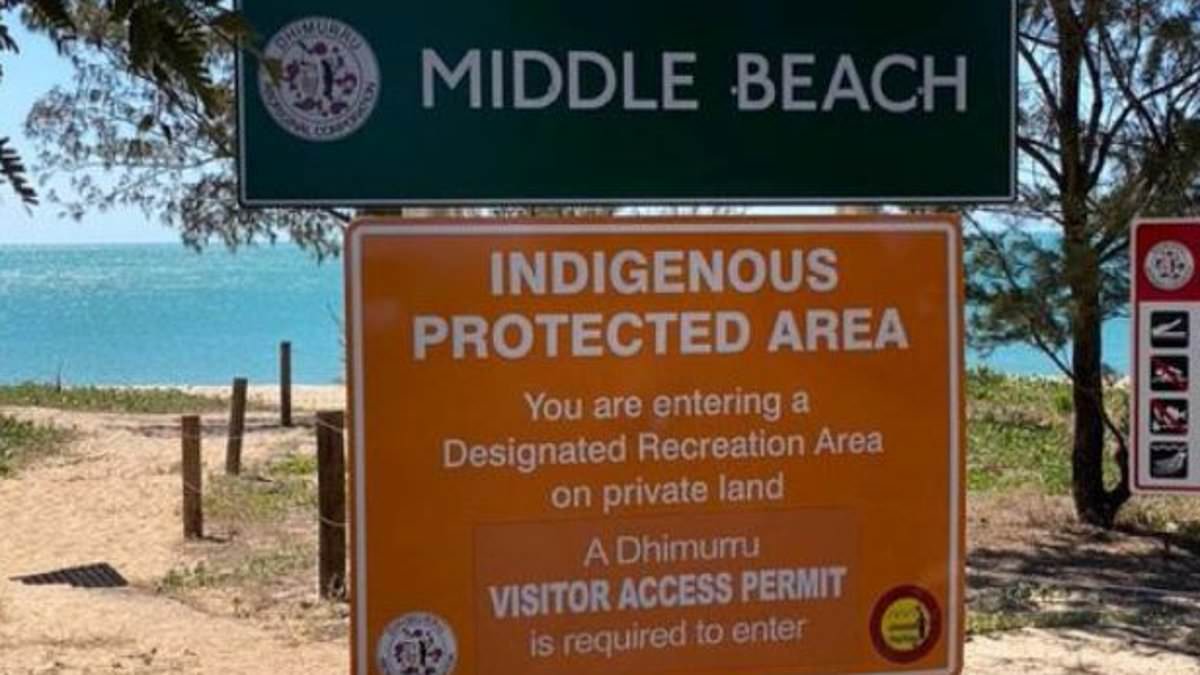Aussies have been left outraged over a sign blocking access to a beach unless visitors have paid for a permit.
A woman was left stunned after making the trip to Middle Beach, also known as Dharrpamiwuy, near the north east tip of Arnhem Land in the Northern Territory.
She shared a photo to social media platform X showing a sign advising it was an ‘Indigenous protected area’.
‘You are entering a designated recreation area on private lands. A Dhimurru Visitor Access Permit is required to enter,’ it read.
The visitor lashed out at the sign saying she would not be ‘stopped from entering public places in my own country’.
‘Looks like a great place to swim. Let’s go!’ she wrote.
A Family Annual Permit, which includes two adults and up to four children, costs $207.50 while an individual must pay $108 for a year’s access.
A one month visitor person will cost an individual $89.25 while a 14-day permit costs $57.60 and a three-day one $39.
Children get issued a permit up to one month for $15.50.
Several social media users vented their anger at having to buy a permit to access the land.
‘The best way to get rid of an obnoxious/unfair law is to continually break it enmasse,’ one said.
‘What kind of government expects you to get a permit to enjoy a beach? The only way all this BS ends is if together we stop conforming to it,’ another said.
‘Taxpayers are footing the bill for the maintenance of these areas. Walk right in,’ a third responded.
Another added: ‘We are taught such a narrow view, no doubt on purpose to create division.’
‘We were all born on this planet, it is our home, all of it. No one group, can claim one part of it when the whole, belongs to all,’ they wrote.
‘Our soul purpose, as custodians is to care for it and that’s simply, leave it as you found it. It’s seems beyond ridiculous, to have to pay to live on a planet you were born on.’
However, some people believed the sign should be heeded.
‘Be thankful that you have indigenous people that care for the land and water,’ they wrote.
‘A purely public beach would likely have trash, or worse. Some indigenous where I’m living in Colombia have been on the land 3,000 years.
‘It is flourishing because they value it above all else.’
Indigenous leader Warren Mundine said the permit system in the Northern Territory was about ‘protecting Aboriginal culture but also stopping people from coming onto their land’
‘It’s very popular amongst Indigenous because it stops people from coming in and bothering them,’ he said.
‘A lot of those beaches and waterways are under Native Title therefore you need to have a permit.
‘The police like it because they are able to police the current act. The structures in the Territory are built around it.’
However, Mr Mundine said he was a bit 50-50 on whether permits were a good thing.
‘I understand the reasons why they want privacy and stuff like that but looking at economic development, tourism in regard to beaches it becomes a bit of a hassle,’ he said.
‘A lot of these roads are paid by government funds even though they are on people’s land
‘That raises the question if we are paying for it should we be able to access them because they should be public road.
‘By not being able to go into some villages the economic opportunity of service stations, shops is lost.’
Another problem with the current system Mr Mundine said was that ‘land councils become all powerful, it becomes a semi-independent state’.
;What it really has created is a very strong power base of lawyers, white lawyers which worked in these land councils.’
Others pointed out there was another sign set-up nearby that warned visitors to be careful of crocodiles.
‘You see that sign but not the one behind it warning of deadly saltwater crocs and deadly stingers inhabit the area?’ one wrote.
‘That’s why the first one is there, because people that are all kinds of stupid don’t read the signs!’
Traditional owners the Yolŋu require permits to travel and visit various areas of East Arnhem Land, which are issued by the non-profit Dhimurru Aboriginal Corporation.
‘The Aboriginal Land Act NT 1978 requires all individuals to have a current permit,’ the corporation’s website said.
‘These permits enable residents and visitors alike to access the recreation areas for day use as much as you like, to walk, visit beaches and inland waterways, fish, BBQ, and so on.
‘They also enable you to purchase a Camping Permit if you are staying overnight in Dhimurru Recreation Areas.’
An Arnhem Land tourist site said Middle Beach ‘features a lovely wide stretch of white sand and plenty of shade from the several casuarina trees scattered about, making it the perfect spot to sit and take in your surrounds’.
‘If you are lucky you may even find one of the local food trucks parked up here serving the likes of fresh fish and chips or pizza,’ the site said.
‘This beach is also the location of one of the Gove Peninsula’s biggest events, the Nhulunbuy Rotary Club’s annual Beach Volleyball Tournament.
